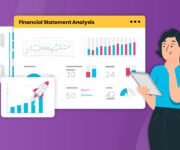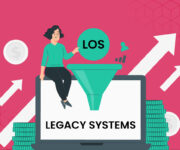Picture this: Most banks run 10-15 separate core systems, like loans, credit cards, and CRM, that do not communicate easily with each other. The result is fragmented data, duplicate customer profiles and siloed records. These issues obscure a borrower’s full financial picture.
This silo problem is widespread. A 2024 survey found 57% of banking executives have yet to achieve a unified customer view, largely due to technical and cost challenges. Without integration, loan officers and credit teams must manually pull data from disparate sources, slowing down the process. This also increases the chance of human errors.
Breaking down these silos is essential for lenders who want faster, more accurate service.
What Is a 360° Lending View
A 360° lending view helps the lender see everything about a borrower in one consolidated profile. This 360° view dashboard is a strategic asset that lets you instantly answer questions like:
- What other loans does this customer have?
- Have they been responsive in past communications?
- Are there warning signs (e.g. missed payments on another product) that should inform this new credit decision?
By integrating customer data across platforms, lenders achieve a full panoramic view of the customer’s financial picture.
Why Unified Customer Data Integration Matters for Lenders
Integrating data to achieve a 360° view brings tangible benefits to lending operations:
Better Risk Management
A unified view of customer data helps you see the total exposure and credit history of a borrower, reducing blind spots. When all loans and accounts are visible together, credit officers can avoid over-lending and detect early warning signs of default that might be missed in siloed systems.
Faster Loan Decisions
When data is integrated, you don’t need to waste time hunting through multiple databases or re-entering information. A bank in the U.S. consolidated data from 54 different systems into one platform to gain a 360° customer view. This led to increased operational efficiency and much quicker workflows.
Personalised Customer Experience
Studies show that around 71% of consumers expect personalised interactions from companies. Those that deliver personalised solutions often see faster revenue growth.
With unified data, you can spot the next best product, offer loans at the right moment, and tailor terms to each borrower’s profile.
Higher Customer Satisfaction and Loyalty
Customers hate repeating details or waiting weeks for approval. An integrated system removes duplicate data and makes the process smoother for customers.
When customers see that their bank “knows” them – for example, a relationship manager who is instantly aware of the customer’s existing loans and past interactions – it builds confidence. These personalised interactions translate to happier customers who are more likely to stay loyal.
Improved Internal Efficiency and Collaboration
With a single integrated data view, different departments can collaborate better using the same up-to-date information.
For example, if a collections team updates a repayment in one system, an integrated setup would reflect that in the CRM immediately. So, a sales officer won’t pitch a new loan to a customer who just missed a payment.
6 Proven Strategies to Integrate Customer Data for 360° Lending View
Here are key strategies for integrating customer data across platforms in the lending context:
Audit and Consolidate Data Sources
Identify all the places where your customer data resides. It may be your loan origination systems, core banking, CRM, credit bureau feeds, accounting software, spreadsheets, etc. This audit lets you plan which systems need to talk to each other.
In some cases, consolidation might mean migrating data into a central repository. In others, it could mean setting up connections so data can be pulled on demand. The goal is to ensure no critical data source remains isolated.
Use APIs and Middleware to Connect Systems
API gateways and middleware solutions can serve as bridges between different software.
For example, an API can push updates from your loan management system to your CRM in real time. When an EMI payment is recorded in the accounting module, the information can automatically reflect in the CRM and loan system.
This sync ensures that all platforms are updated simultaneously.
Establish a Single Customer ID Across Platforms
One technical challenge in integration is matching records for the same person in different databases. Implementing a common customer identifier ensures that data from various sources combine into one profile per customer.
This might involve using a unique ID, like a customer reference number, across all systems.
Centralise Data for a Unified View
Create a central data hub or warehouse that aggregates your key customer data from all systems. This doesn’t mean you must rip-and-replace existing systems. Instead, you can have a master database (or a Customer Data Platform) that pulls in information and keeps it updated.
Many banks choose a CRM platform or an analytics dashboard as the front-end for the 360° view, with back-end integration feeding it data.
Leverage Open Banking and External Data
A true 360° borrower view often requires external data as well. Thanks to open banking initiatives and data-sharing frameworks, lenders can integrate external financial data with customer consent.
In India, the RBI’s Account Aggregator (AA) system lets borrowers share bank statements, tax data, insurance records, and more through licensed platforms.
With APIs or AA integrations, lenders can enrich internal data with transaction history, GST invoices, and other indicators that assess creditworthiness more accurately.
Adopt an Integrated Lending Platform
Another approach is to implement a modern end-to-end lending solution that inherently breaks down silos.
For instance, Finezza offers an end-to-end lending suite that is software- and platform-agnostic, with secure APIs and data pipelines that can be easily integrated into your existing infrastructure.
For example, Finezza’s end-to-end lending platform serves as a central hub for all customer lending data, connecting seamlessly with external services like KYC providers, credit bureaus, and accounting tools via APIs.
The entire Finezza product suite, for example, is available as easy-to-integrate APIs. Therefore, a bank can plug it into legacy systems or third-party apps without heavy custom development.
Choosing technology that “plays well” with others is a smart shortcut to achieving a 360° view.
Final Thoughts
The 360° lending view turns scattered data into a strategic asset. It lets lenders see the whole borrower, not just fragmented pieces. This holistic insight is the key to lending more profitably in the evolving financial services market.
With a clear integration roadmap and the right tools, any lending institution can move toward a unified customer view.
Ready to transform fragmented data into profitable lending decisions? Get a personalised demo of Finezza’s integration capabilities and discover how leading lenders achieve a true 360° customer view. Contact us today or book a consultation




Leave a Reply